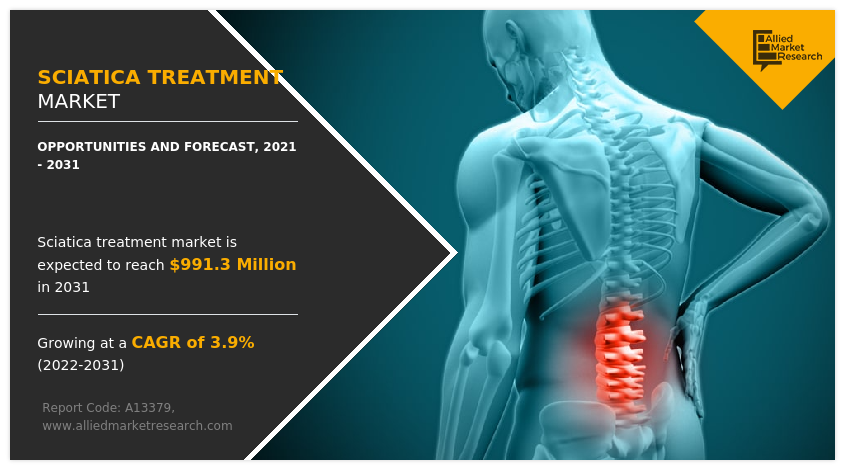
Sciatica Treatment Market: Growth Trends, Key Drivers, and Emerging Opportunities

Sciatica Treatment Market------
PORTLAND, OR, UNITED STATES, February 18, 2025 /EINPresswire.com/ -- The global sciatica treatment market is on a steady growth trajectory, projected to rise from $678 million in 2021 to $991.3 million by 2031, reflecting a compound annual growth rate (CAGR) of 3.9%. This growth is driven by increasing incidences of sciatica, advancements in treatment options, and a rising geriatric population. Below, we explore the key market drivers, emerging trends, and industry challenges shaping this expanding sector.
Get a Sample Copy of this Report: https://www.alliedmarketresearch.com/request-sample/A13379
Understanding Sciatica
Sciatica is a condition characterized by pain radiating along the sciatic nerve, extending from the lower back through the hips and down the legs. It is commonly caused by nerve compression due to conditions such as herniated discs, spinal stenosis, or osteoarthritis. Sciatica can be acute, chronic, or intermittent, with chronic cases being the most prevalent, particularly among the elderly.
Key Market Drivers
1. Rising Prevalence of Sciatica
• Sedentary lifestyles and prolonged sitting contribute to an increasing number of sciatica cases worldwide.
• Conditions such as herniated discs, spinal stenosis, and osteoporosis are key contributors to the rise in sciatica incidence.
2. Aging Population
• The growing global geriatric population is more prone to degenerative spinal conditions, leading to increased demand for sciatica treatments.
• Older adults often require long-term management for chronic sciatica pain.
3. Advancements in Treatment Options
• Non-steroidal anti-inflammatory drugs (NSAIDs) remain the most widely used treatment for sciatica pain due to their effectiveness and availability.
• Emerging therapies, including biologics and regenerative medicine, offer promising alternatives for long-term pain relief.
4. Growth in Online Distribution Channels
• The convenience and cost-effectiveness of online pharmacies are driving their popularity among patients seeking sciatica medications.
• Digital platforms provide easy access to both prescription and over-the-counter (OTC) drugs, boosting market expansion.
Market Segmentation
The sciatica treatment market is segmented based on type, drug class, distribution channel, and region.
By Type
• Acute Sciatica: Short-term pain lasting a few weeks.
• Chronic Sciatica: Long-term pain persisting for months or years, commonly affecting elderly individuals.
By Drug Class
• NSAIDs: The leading segment in 2021, expected to grow at the highest CAGR due to their widespread use.
• Steroids: Used for severe inflammation but limited due to potential long-term side effects.
• Antidepressants: Frequently prescribed for nerve-related pain management.
By Distribution Channel
• Retail and Specialty Pharmacies: Accounted for the largest market share in 2021 due to accessibility.
• Online Providers: Expected to grow at the highest CAGR, driven by convenience and affordability.
By Region
• North America: Held the largest market share in 2021, supported by advanced healthcare infrastructure and high awareness.
• Asia-Pacific: Expected to grow at the highest CAGR due to increasing healthcare investments and rising disease prevalence.
Emerging Trends and Opportunities
1. Non-Invasive and Holistic Treatments
• Increasing patient preference for non-surgical treatments such as chiropractic care, acupuncture, and physical therapy.
• Holistic treatment options offer long-term relief with minimal side effects, gaining traction among patients.
2. R&D in Pharmaceutical Treatments
• Leading pharmaceutical companies are investing in innovative drugs and active pharmaceutical ingredients (APIs) for sciatica treatment.
• The growing role of contract research organizations (CROs) in outsourcing drug development activities.
3. Focus on Emerging Markets
• Asia-Pacific and Latin America, Middle East & Africa (LAMEA) regions present lucrative opportunities due to increasing awareness and healthcare advancements.
• Countries such as China and India are witnessing a high adoption rate of sciatica medications.
Challenges in the Market
1. High Cost of Advanced Therapies
• Cutting-edge treatments such as biologics and regenerative medicine are often expensive, limiting accessibility in lower-income regions.
2. Side Effects of Prolonged Medication Use
• Long-term use of NSAIDs and steroids may lead to adverse effects, creating a demand for safer alternatives.
3. Unequal Access to Specialized Treatments
• Developing regions face challenges in accessing advanced therapies due to inadequate healthcare infrastructure.
Competitive Landscape
The sciatica treatment market is highly competitive, with major players focusing on innovation and strategic partnerships. Key companies include:
• Abbott
• Johnson & Johnson
• Teva Pharmaceutical Industries Limited
• Sun Pharmaceutical Industries Ltd.
• Sinfonia Biotherapeutics
Recent Developments
• November 2022: Sinfonia Biotherapeutics received FDA approval for Phase IIb studies of SB0101 for chronic sciatica treatment.
• March 2021: Abbott launched Brufen Power Spray, a double-strength diclofenac formulation for pain relief.
Future Outlook
The sciatica treatment market is poised for significant expansion, driven by technological advancements, rising disease prevalence, and increasing demand for non-invasive treatments. However, overcoming challenges such as high treatment costs and disparities in access will be crucial for sustained growth.
Key Takeaways
• The global sciatica treatment market is projected to reach $991.3 million by 2031.
• Chronic sciatica and NSAIDs dominate the market, while online distribution channels are experiencing rapid growth.
• Asia-Pacific presents significant growth opportunities due to rising healthcare investments.
• Non-invasive treatments and holistic approaches are gaining popularity.
• Continued R&D investments and strategic partnerships are shaping the competitive landscape.
As the industry evolves, stakeholders must focus on innovation, affordability, and accessibility to meet the increasing demand for effective sciatica treatments worldwide.
Enquire Before Buying: https://www.alliedmarketresearch.com/purchase-enquiry/A13379
David Correa
Allied Market Research
+1 800-792-5285
email us here
Visit us on social media:
Facebook
X
LinkedIn
YouTube
Distribution channels: Business & Economy, Healthcare & Pharmaceuticals Industry
Legal Disclaimer:
EIN Presswire provides this news content "as is" without warranty of any kind. We do not accept any responsibility or liability for the accuracy, content, images, videos, licenses, completeness, legality, or reliability of the information contained in this article. If you have any complaints or copyright issues related to this article, kindly contact the author above.
Submit your press release